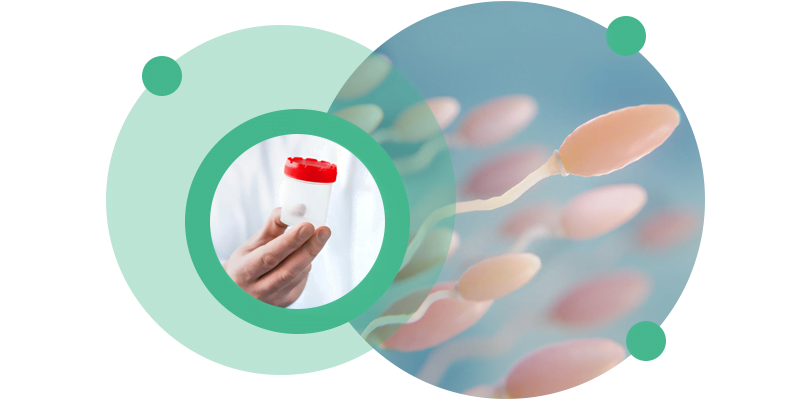Spermogram
The spermogram – sperm analysis – is the first additional diagnostic test needed to assess a man’s fertility potential.The spermogram – sperm analysis – is the first additional diagnostic test needed to assess a man’s fertility potential. It is a simple test to perform, but it must comply with a few basic rules of collection and evaluation in order to be credible and validated in an appropriate and reliable manner.
Therefore, for correct interpretation, it is essential that all laboratory work is standardised according to reference values. There is a consensus that current semen analysis should follow the guidelines defined internationally by the World Health Organisation.
As well as checking the quality and quantity of the various components of semen, the spermogram also allows more complex additional tests to be carried out.

About spermograms
The spermogram – semen analysis – is the first additional diagnostic test needed to assess a man’s fertility potential. It is a simple examination in which sperm ejaculated during masturbation is obtained and then processed in a certified laboratory in order to evaluate certain parameters that will enable us to assess the fertile potential and general and specific abnormalities of the sperm. production.
The main parameters to be assessed are sperm concentration, motility and morphology. Total ejaculate volume, pH, viscosity, colour and liquefaction time are also assessed. It is essential that all laboratory processing of the sperm obtained is standardised according to reference values and that the evaluation is carried out within 30 minutes of ejaculation.
Current sperm analysis must follow the guidelines defined internationally by the World Health Organisation. The values considered as reference are:
- Ejaculate volume – Greater than 1.4 ml
- pH – Greater than 7.2
- Sperm concentration – Greater than 16 million per ml
- Total motility – Greater than 42%
- Progressive motility – Greater than 30%
- Morphology (normal forms) – Greater than 4%
- Vitality (% live sperm) – Greater than 54%.
It is essential to remember that we are talking about reference values and should not be interpreted as a source of clear and definitive diagnosis, but rather as a form of diagnostic and therapeutic guidance. In other words, there are many situations of male infertility in which all these parameters are normal, as well as other situations of proven paternity in which there may be one or more changes in each of these seminal parameters assessed.
The spermogram also enables other seminal parameters to be assessed in specific situations, according to very clear indications that vary from one man to another. These include the presence of leucocytes to detect infection of the seminal tract, and measurements of certain substances derived from the prostate and seminal fluid. These include the presence of vesicles in the ejaculate, which are responsible for its better or poorer quality, and the rate of fragmentation of sperm DNA, a parameter that is now internationally recognised as fundamental for effective oocyte fertilisation.
The purpose of a spermogram is to assess a man’s fertility potential. This examination is part of the evaluation of infertile couples.
By analysing the parameters assessed (and in conjunction with other complementary diagnostic tests), this examination provides an insight into the male reproductive system, enabling the best therapeutic approach to be chosen to enable a natural pregnancy to be achieved, in line with the woman’s reproductive potential .
Similarly, in more specific situations, the spermogram will also make it easier to decide on the best medically assisted procreation technique to use, whether artificial insemination (AI) or in vitro fertilisation (IVF), whether or not using the intracytoplasmic sperm injection (ICSI) method.
The spermogram is absolutely indicated in all situations of marital infertility.
Infertility is defined as the inability of a sexually active couple, without any type of contraception, to achieve a spontaneous pregnancy within one year. Primary infertility refers to couples who have never had children and who are unable to become pregnant after at least 12 consecutive months of sexual intercourse without using contraception. Secondary infertility refers to infertile couples who have managed to become pregnant at least once before (with the same or another sexual partner).
Around 15% of couples do not become pregnant within a year and consult a doctor for infertility. One couple in eight encounters difficulties when trying to conceive their first child and one in six when trying to conceive a subsequent child.
In 50% of childless couples, there is a factor associated with male infertility, generally associated with abnormal sperm parameters. Therefore, in all infertile couples, the man should be assessed by a urologist specialising in male reproduction (andrology differentiation), with the spermogram being the laboratory diagnostic method initially recommended.
Sperm analysis is also indicated for all men undergoing bilateral vasectomy as a permanent contraceptive method. After the operation, regular ejaculatory activity should be maintained and a spermogram performed after approximately 3 months. The result should indicate a complete absence of spermatozoa in the ejaculate (azoospermia), attesting to the success of the operation and allowing unprotected sexual intercourse.
There are other situations, particularly in oncology, in which a spermogram is essential. When it is necessary to undergo treatments requiring surgical removal of a testicle, as well as radiotherapy and/or chemotherapy, cryopreservation of spermatozoa for future paternity is essential, given the possibility of irreversible damage to sperm production caused by this type of treatment.
It is therefore essential to check the sperm parameters in order to validate the possibility of cryopreserving quality sperm before carrying out this type of treatment.
The spermogram is absolutely indicated in all situations of marital infertility.
Infertility is defined as the inability of a sexually active couple, without any type of contraception, to achieve a spontaneous pregnancy within one year. Primary infertility refers to couples who have never had children and who are unable to become pregnant after at least 12 consecutive months of sexual intercourse without using contraception. Secondary infertility refers to infertile couples who have managed to become pregnant at least once before (with the same or another sexual partner).
Around 15% of couples do not become pregnant within a year and consult a doctor for infertility. One couple in eight encounters difficulties when trying to conceive their first child and one in six when trying to conceive a subsequent child.
In 50% of childless couples, there is a factor associated with male infertility, generally associated with abnormal sperm parameters. Therefore, in all infertile couples, the man should be assessed by a urologist specialising in male reproduction (andrology differentiation), with the spermogram being the laboratory diagnostic method initially recommended.
The spermogram is also indicated for all men undergoing bilateral vasectomy as a permanent contraceptive method. After the operation, regular ejaculatory activity must be maintained and a spermogram should be performed after approximately 3 months. The result should indicate a complete absence of spermatozoa in the ejaculate (azoospermia), attesting to the success of the operation and allowing unprotected sexual intercourse.
There are other situations, particularly in oncology, in which a spermogram is essential. When it is necessary to undergo treatments requiring surgical removal of a testicle, as well as radiotherapy and/or chemotherapy, cryopreservation of spermatozoa for future paternity is essential, given the possibility of irreversible damage to sperm production caused by this type of treatment.
It is therefore essential to check the sperm parameters in order to validate the possibility of cryopreserving quality sperm before carrying out this type of treatment.
Yes, but this is not the ideal procedure. The ejaculate must be assessed within 30 minutes of collection and there must be no temperature variations during transport. It is recommended that during transport to the Reproduction Centre, it is kept close to the body to avoid these variations as much as possible.
It is therefore recommended that the collection be carried out in the Reproduction Centre’s facilities, where there is generally a quiet area reserved for this purpose, allowing the use of erotic/sexual auditory and visual stimuli, in order to provide adequate stimulation to promote orgasm and ejaculation.
Consequently, we only facilitate this rule in very specific situations in which there are difficulties on the part of the man in achieving ejaculation in an environment outside his comfort zone. The collection vessel is sterile and supplied by the Reproduction Centre, but a basic urine collection vessel can also be obtained from a pharmacy.
If the semen analysis is normal according to WHO criteria, a single test is sufficient. In all other circumstances, at least 2 spermograms are always necessary to assess the stability and validation of the test. If the results are abnormal on at least two tests, further andrological investigation is indicated. It is important to differentiate between the following findings:
- Oligozoospermia: 16 million sperm cells/ml
- Azoospermia: absence of spermatozoa in the ejaculate. In azoospermia, semen analysis may show normal ejaculate volume and azoospermia must be confirmed after centrifugation. A recommended method is centrifugation of the semen at 3,000g for 15 minutes and full microscopic examination under a phase contrast light microscope at 200X magnification. All samples should be stained and re-examined under the microscope. This ensures that even small numbers of sperm can be detected and potentially used for intracytoplasmic sperm injection (ICSI), eliminating the need for surgery.
- Asthenozoospermia: 30% progressive motile spermatozoa
- Teratozoospermia: 4% of normal forms
None of the individual sperm parameters (e.g. concentration, morphology and motility) on its own is diagnostic of infertility. Often, all three abnormalities occur simultaneously, which is defined as oligoasthenoteratozoospermia (OAT) syndrome.
As with azoospermia (the complete absence of sperm in the ejaculate), in severe cases of oligozoospermia (sperm < 5 million/ml) there is an increased incidence of male genital tract obstruction and genetic abnormalities. In these cases, a more complete assessment of the hormonal profile may be useful for a more accurate and differential diagnosis of different pathological conditions.
Common questions
Yes, this is more common than is usually reported. Although it is not a common occurrence, there are cases in which the pressure of ‘having to comply’ to provide an ejaculate sample can psychologically inhibit the orgasmic process and thus prevent the sample from being obtained. In these highly stressful situations, the presence of a partner is suggested for better erotic stimulation, but also to help with the physical and/or psychological relaxation aspect. In exceptional cases, the collection site may be your own home or a hotel room, where ‘adverse environmental’ conditions can be diluted. Being nervous, stressed or inhibited will not change the analytical results of the examination.
You can consult the CETI price list here.
The result of the examination itself does not change. However, if the erectile dysfunction is moderate/severe, there may be increased difficulty in achieving orgasm and ejaculation. Your Urologist/Andrologist will be able to help you overcome this, as well as others that may arise at the time or have been present before.
No, this is irrelevant. Even men with documented premature ejaculation do not show different values in the spermogram parameters compared with men who fall within the general norms for so-called ‘normal’ ejaculatory time.
In very special situations, the clinical staff at the Reproduction Centre may request a sperm collection very close to the previous one. However, as a general rule, the next collection must respect the usual period of sexual abstinence (3 to 5 days).
